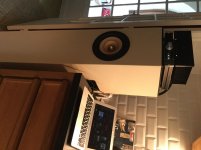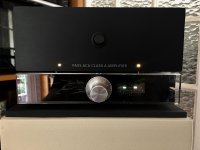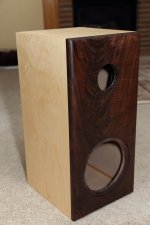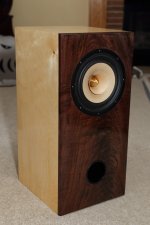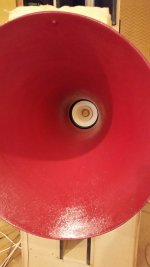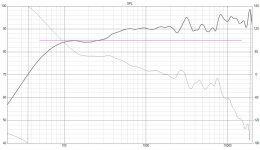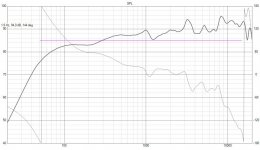Pass DIY Addict
Joined 2000
Paid Member
Good morning Eric,
I am not frustrated on bass restitution with the TB W81772. It’s an excellent driver and it has a profound potential: on some excellent recording music, I am surprised by how low it can go down in the sound spectrum...for exemple on this track: « Ecor rouge » of the album « you should be so lucky » from the pianist Benmont Tench. Yes, it depend the source richness and of course its placement in the listening room. The only problem was an harshness, a kind of acidity but magicaly the add of a baffle step correction fixed it and now it’s a real pleasure... I have the feeling, it becomes with time more and more enjoyable... is it the famous burning effect or my habit to is sound signature...
Here is a picture of it:
I use it in nomadic mode in my home (it’s on rolls- is my secondary system) and mono ( not stereo) with ACA amp and B1 Nutube pre.
Can you show me your speaker please?
Musically
Thierry
I am not frustrated on bass restitution with the TB W81772. It’s an excellent driver and it has a profound potential: on some excellent recording music, I am surprised by how low it can go down in the sound spectrum...for exemple on this track: « Ecor rouge » of the album « you should be so lucky » from the pianist Benmont Tench. Yes, it depend the source richness and of course its placement in the listening room. The only problem was an harshness, a kind of acidity but magicaly the add of a baffle step correction fixed it and now it’s a real pleasure... I have the feeling, it becomes with time more and more enjoyable... is it the famous burning effect or my habit to is sound signature...
Here is a picture of it:
I use it in nomadic mode in my home (it’s on rolls- is my secondary system) and mono ( not stereo) with ACA amp and B1 Nutube pre.
Can you show me your speaker please?
Musically
Thierry
Attachments
Pass DIY Addict
Joined 2000
Paid Member
This is my Tang Band bass reflex box. It's about 24" high, 12" wide and 12" deep. It works out to about 38L. The vent is 3" diam and about 6" long. The wood is Baltic Birch on the top and sides with a Walnut front baffle. It just received a coat of Tung Oil and after it soaks in for about a week, it will get several coats of Formby's Tung Oil Finish. When this cabinet is pushed up against the wall, it produces enough bass to be happy with.
Attachments
One more thing to add though.
Asking the 1772 to put out meaningful bass on its own kinda defeats the purpose of the extremely light and delicate cone.
I have had the 1772 in a vented 40-ish litre box, and using a couple of notches, it was sounding quite nice.
Small jazz ensembles, vocals, folk guitar, these the 1772 would do a great job. But pushing them with some more meaty music, they would struggle a little.
Adding woofers to free them of the low end (around 200Hz, or even better 500Hz) would free them to do what they do best.
Even adding a sub crossed at the usual 150Hz would still help them a lot.
Asking the 1772 to put out meaningful bass on its own kinda defeats the purpose of the extremely light and delicate cone.
I have had the 1772 in a vented 40-ish litre box, and using a couple of notches, it was sounding quite nice.
Small jazz ensembles, vocals, folk guitar, these the 1772 would do a great job. But pushing them with some more meaty music, they would struggle a little.
Adding woofers to free them of the low end (around 200Hz, or even better 500Hz) would free them to do what they do best.
Even adding a sub crossed at the usual 150Hz would still help them a lot.
One more thing to add though.
Asking the 1772 to put out meaningful bass on its own kinda defeats the purpose of the extremely light and delicate cone.
I have had the 1772 in a vented 40-ish litre box, and using a couple of notches, it was sounding quite nice.
Small jazz ensembles, vocals, folk guitar, these the 1772 would do a great job. But pushing them with some more meaty music, they would struggle a little.
Adding woofers to free them of the low end (around 200Hz, or even better 500Hz) would free them to do what they do best.
Even adding a sub crossed at the usual 150Hz would still help them a lot.
Agree 100%. I use my pair above 250Hz, 18db/oct, front horn loaded, and I consider them to be world class, especially since being driven by an s.e.t. amp.
Pass DIY Addict
Joined 2000
Paid Member
Pass DIY Addict
Joined 2000
Paid Member
Here is a pic of my newly finished cabinets for my TB drivers. Approx 40L bass reflex with a 3" x 6" port. Sides are baltic birch, front is walnut. Finish is one coat of pure tung oil with 5-8 coats (I lost count) of Formby's Tung Oil Finish on top of that. I'm presently using an outboard 0.56mH inductor in parallel with a 15R resistor placed in series with the driver.
Attachments
Pass DIY Addict
Joined 2000
Paid Member
TYM: What do you think of the bass that is produced by this design? Are you happy listening to it without a sub? I just laminated my 38L bass reflex box with some baltic birch and walnut for the front. Looks much better, but still a bit bass shy for some recordings.
Good morning Eric,
I am not frustrated on bass restitution with the TB W81772. It’s an excellent driver and it has a profound potential: on some excellent recording music, I am surprised by how low it can go down in the sound spectrum...for exemple on this track: « Ecor rouge » of the album « you should be so lucky » from the pianist Benmont Tench. Yes, it depend the source richness and of course its placement in the listening room. The only problem was an harshness, a kind of acidity but magicaly the add of a baffle step correction fixed it and now it’s a real pleasure... I have the feeling, it becomes with time more and more enjoyable... is it the famous burning effect or my habit to is sound signature...
Here is a picture of it:
I use it in nomadic mode in my home (it’s on rolls- is my secondary system) and mono ( not stereo) with ACA amp and B1 Nutube pre.
Can you show me your speaker please?
Musically
Thierry
This is my Tang Band bass reflex box. It's about 24" high, 12" wide and 12" deep. It works out to about 38L. The vent is 3" diam and about 6" long. The wood is Baltic Birch on the top and sides with a Walnut front baffle. It just received a coat of Tung Oil and after it soaks in for about a week, it will get several coats of Formby's Tung Oil Finish. When this cabinet is pushed up against the wall, it produces enough bass to be happy with.
One more thing to add though.
Asking the 1772 to put out meaningful bass on its own kinda defeats the purpose of the extremely light and delicate cone.
I have had the 1772 in a vented 40-ish litre box, and using a couple of notches, it was sounding quite nice.
Small jazz ensembles, vocals, folk guitar, these the 1772 would do a great job. But pushing them with some more meaty music, they would struggle a little.
Adding woofers to free them of the low end (around 200Hz, or even better 500Hz) would free them to do what they do best.
Even adding a sub crossed at the usual 150Hz would still help them a lot.
I'm curious to understand why so many people seem to be trying to use the W8-1772 in a bass reflex cabinet when the Qts is far too low for an optimal bass response. No wonder the bass seems a bit thin.
If you're intending to produce bass with it why not go for the more suitable W8-1808 which has 5mm Xmax instead of the 3mm Xmas of the W8-1772, a slightly larger diameter voice coil, and a higher Qts that lends itself well to bass reflex designs ?
Having looked at the specs of both drivers I would choose the 1772 if you were cutting it off below about 200Hz and passing over to a woofer of some kind, but if you want to produce bass as well the 1808 seems the obvious choice.
I have my Coral Flat 8 Mk 2's in a 43 litre bass reflex enclosure tuned to 41Hz using two 75mm diameter, 200mm long rear mounted ports.
This works remarkably well and I'm consistently impressed by how good the bass response is for a full range driver with such a light cone. (At least in a typical UK sized living room)
The Flat 8 Mk2 has the same cone area as the 1772/1808, about the same moving cone mass, (about 9 grams) the same 3mm Xmax as the 1772, and the other Thiele small parameters like sensitivity and Qts are very close to that of the 1808.
In other words the 1808 should work well in the same bass reflex cabinets as my Coral drivers, and probably better due to increased Xmax and underhung voice coil design with Neodynium magnet.
I'd also like to suggest that a single 3" / 75mm port mentioned above is too small in area for an 8" driver, even for a driver with only a 3mm Xmax, and that doubling the port area (and making it/them longer to tune back to the same box resonance) will improve the bottom end performance at higher SPL and reduce dynamic compression effects considerably, giving more low end punch at higher SPL where the smaller port would cause loss of loading on the driver and increased driver excursion and reduced output. (Not to mention chuffing)
I originally had a single 75mm diameter port on these cabinets, approximately 60mm long to get the correct box tuning (such a short port should be a clue in hindsight that the port area was too small) and there was noticable chuffing.
I later changed to two 75mm ports on the back - one 1/3rd of the way from the top of the cabinet and one 1/3rd of the way from the bottom with the driver in the middle of the front panel.
Not only did the chuffing go away the dynamic performance in the low frequency range where the ports are mainly active - from about 35 Hz to 50Hz improved dramatically, and they have plenty of punch in that region while the cone hardly moves.
So anyone not happy with their bass response who is using one 75mm port, if you have room for the additional port length consider increasing the port area by using two, longer ports, or switch to a bigger diameter, longer single port to achieve the same doubling of area. (Two ports was easier for me)
The next thing I would suggest for those that insist on using a 1772 (instead of an 1808) in a bass reflex enclosure or have already bought it and have second thoughts about its performance in a bass reflex enclosure is..... connect a resistor in series with it to raise the Qes...
I'll probably get a few groans from the audience for this but the correct value of resistance will increase the Qes of the driver to about the same as the 1808, and simultaneously drop the sensitivity from 95dB to 93dB'ish of the 1808.
In other words by simply connecting a resistor in series (a decent 10/20 watt one) you will get most of the properties of the 1808 that make it suitable for bass reflex designs, minus the increased Xmax. So it won't have quite the bass performance of an 1808 but it should be reasonably close.
I don't know without running some box sims with both drivers what the value should be, but it's probably in the range of 1-3 ohms, and can probably be tuned empically to optimise the balance of the bass response.
This resistor will of course affect the response at higher frequencies due to the impedance curve of the speaker, especially if you have any sort of passive EQ, so you will most likely have to re-adjust any active or passive EQ or add EQ afterwards to rebalance the midrange and treble.
The next thing I would suggest is don't forget baffle step correction... for some reason full range driver fans see baffle step correction (or any equalisation) as anathema, and expect their drivers to somehow bend the laws of physics - they won't.
If you put a full range driver in a free standing bass reflex box and don't apply any baffle step correction the bass will be weak. It's physics. End of debate. With enough listening you can adapt to this and start to delude yourself that the bass response is OK, but it isn't.
So there needs to be some baffle step correction, but getting the amount of correction and the rollover point correct isn't always easy. The correct rollover frequency for the high frequency cut is hard to predict and in my experience room effects mean that the theoretically predicted rollover frequency based on the width of the baffle is seldom right.
I use that as a starting point but I inevitably find I have to lower the rollover frequency significantly below what predictions suggest to get the balance right, and it takes some tuning by ear to nail it exactly.
I have a full 6dB baffle step correction on my Coral drivers, and while theory says the rollover frequency should be about 300Hz based on baffle width I've actually ended up with much larger coils bringing it down to about 200Hz. At 300Hz it just sounded "wooly" due to an excess of low midrange and trying to reduce the total amount of baffle step correction instead just made it sound weak in the bass and wooly at the same time...
With the right box, ports, baffle step correction and a tweak to the Qes using a series resistor the 1772 should still be able to produce surprisingly decent bass down to about 40Hz in a small to medium room, and the 1808 should be able to do even better, without the extra resistor.
I'm looking forward to sampling the W8-1772 when I get the time and money to play around with a pair, however I will be cutting them off below 250Hz. If I was trying to use them for bass as well I would get the W8-1808.
Last edited:
I use the 1772 above 250Hz, and front-horn load it, to boot. The horn *lifts* the otherwise anemic lower mid-range level. In this manner, the sound quality is SUPERB,and will only be bested by spending multiples of times more money. I also should mention that after ears and years of enjoying the sound, albeit with a slight "recessed" upper mid-range, I now use a single-ended, class A,
5 watt amp. This has transformed an excellent sound quality into one I would have to rate as sublime p.s. I do use a ribbon tweeter above 8kHz.
p.s. I do use a ribbon tweeter above 8kHz.
5 watt amp. This has transformed an excellent sound quality into one I would have to rate as sublime
Attachments
Last edited by a moderator:
I'm back looking at the W8-1772 again, and I wonder if anyone can reassure me about some measurements I've seen...
The following pages have frequency response measurements made by "Rutcho", (who I think posted in this thread over 10 years ago! If you're still reading this thread, hello ) and I'm troubled by the apparent huge difference in frequency response between the W8-1808 and W8-1772 which in theory should have a quite similiar frequency response:
) and I'm troubled by the apparent huge difference in frequency response between the W8-1808 and W8-1772 which in theory should have a quite similiar frequency response:
Tang Band W8-1772 Fullrange Loudspeaker Measurements Data and Information Full Range
Tabg Band W8-1808 Fullrange Loudspeaker Measurements Data and Information Full Range
The bass roll off will of course be quite different due to the different Q, and treble response is likely to differ due to the difference in voice coil inductance, and also perhaps due to the slightly different voice coil diameter (which will affect the "throat" diameter of the horn formed by the whizzer cone for high frequencies) however I would expect from about 200Hz to maybe 5Khz they should be fairly similar, given the very similar construction and design.
However the frequency response measurements shown on the site above are utterly different as if they are totally different drivers.
In particular, the 1808 appears to be much smoother in the critical upper midrange region, apart from a peak at about 3.5Khz which could be easily corrected with a notch filter. Meanwhile the 1772 looks a lot more rugged from 2-5Khz and not easily correctable.
There is also a massive difference in apparent off axis performance of the drivers with the 1808 not really starting to beam until about 4Khz (which is consistent with the measurements of my Coral Flat 8 II - which also don't start to beam until 4Khz) while the 1772 measurements show beaming starting at only 2Khz, (typical of an 8" driver without a whizzer cone) and severe off axis cancellation at 5Khz not showing on the 1808.
I've done enough driver measurements of my own to know just how difficult they are to get right and get consistent, and it appears that the different graphs are taken in very different measurement conditions, and that the measurements (at least of the 1772) include considerable baffle diffraction that make the driver look worse (especially off axis) than it really is.
In fact the two 1772 measurements specifically say one is taken on a "universal horn" (how wide is that ?) and the other in an 18 litre sealed box (how wide ?) which is pretty small, so baffle diffraction is going to be a big issue with such a small baffle. The peak and dip straddling 1Khz is at quite different frequencies between those two measurements so clearly the box diffraction is within the time window used in the measuremet. (Impossible to avoid with a narrow baffle)
On the other hand the 1808 graph doesn't say under what conditions it was measured, but it looks a lot more like an "infinite" baffle measurement where the time delay of the baffle edge diffraction is outside the measurement window - eg a true raw response of the driver without baffle effects.
So has anyone measured both these drivers in the exact same measurement conditions ? And has anyone measured the drivers raw response flush mounted on an infinite baffle with the diffraction correctly windowed out ?
While an "in box" measurement as that 1772 measurement seems to be is useful for designing a filter to match the in box response of the driver, it's not very useful for evaluating the raw potential of the driver, (eg which peaks and dips are the fault of the driver and which are box diffraction in the specific measurement conditions ?) nor comparing two different drivers if the measurement conditions are so different...
One other comment on those measurements - the distortion from 500-5000Hz seems quite high (hitting 1% at 1W) for a large 8" driver with an underhung voice coil, neodynium magnet and copper shorting rings ? I would have expected a lot better to be honest.
My Coral Flat 8 II's are an overhung design with a relatively cheap ceramic magnet and no shorting rings which should have considerably worse distortion than the Tangband design yet harmonic distortion in the midrange is under 0.5% at significantly more than 1W when I've tested them. Are those distortion measurements accurate or also a bit suspect ?
The following pages have frequency response measurements made by "Rutcho", (who I think posted in this thread over 10 years ago! If you're still reading this thread, hello
Tang Band W8-1772 Fullrange Loudspeaker Measurements Data and Information Full Range
Tabg Band W8-1808 Fullrange Loudspeaker Measurements Data and Information Full Range
The bass roll off will of course be quite different due to the different Q, and treble response is likely to differ due to the difference in voice coil inductance, and also perhaps due to the slightly different voice coil diameter (which will affect the "throat" diameter of the horn formed by the whizzer cone for high frequencies) however I would expect from about 200Hz to maybe 5Khz they should be fairly similar, given the very similar construction and design.
However the frequency response measurements shown on the site above are utterly different as if they are totally different drivers.
In particular, the 1808 appears to be much smoother in the critical upper midrange region, apart from a peak at about 3.5Khz which could be easily corrected with a notch filter. Meanwhile the 1772 looks a lot more rugged from 2-5Khz and not easily correctable.
There is also a massive difference in apparent off axis performance of the drivers with the 1808 not really starting to beam until about 4Khz (which is consistent with the measurements of my Coral Flat 8 II - which also don't start to beam until 4Khz) while the 1772 measurements show beaming starting at only 2Khz, (typical of an 8" driver without a whizzer cone) and severe off axis cancellation at 5Khz not showing on the 1808.
I've done enough driver measurements of my own to know just how difficult they are to get right and get consistent, and it appears that the different graphs are taken in very different measurement conditions, and that the measurements (at least of the 1772) include considerable baffle diffraction that make the driver look worse (especially off axis) than it really is.
In fact the two 1772 measurements specifically say one is taken on a "universal horn" (how wide is that ?) and the other in an 18 litre sealed box (how wide ?) which is pretty small, so baffle diffraction is going to be a big issue with such a small baffle. The peak and dip straddling 1Khz is at quite different frequencies between those two measurements so clearly the box diffraction is within the time window used in the measuremet. (Impossible to avoid with a narrow baffle)
On the other hand the 1808 graph doesn't say under what conditions it was measured, but it looks a lot more like an "infinite" baffle measurement where the time delay of the baffle edge diffraction is outside the measurement window - eg a true raw response of the driver without baffle effects.
So has anyone measured both these drivers in the exact same measurement conditions ? And has anyone measured the drivers raw response flush mounted on an infinite baffle with the diffraction correctly windowed out ?
While an "in box" measurement as that 1772 measurement seems to be is useful for designing a filter to match the in box response of the driver, it's not very useful for evaluating the raw potential of the driver, (eg which peaks and dips are the fault of the driver and which are box diffraction in the specific measurement conditions ?) nor comparing two different drivers if the measurement conditions are so different...
One other comment on those measurements - the distortion from 500-5000Hz seems quite high (hitting 1% at 1W) for a large 8" driver with an underhung voice coil, neodynium magnet and copper shorting rings ? I would have expected a lot better to be honest.
My Coral Flat 8 II's are an overhung design with a relatively cheap ceramic magnet and no shorting rings which should have considerably worse distortion than the Tangband design yet harmonic distortion in the midrange is under 0.5% at significantly more than 1W when I've tested them. Are those distortion measurements accurate or also a bit suspect ?
Last edited:
The Fast 8 Looks like a conical whizzer cone with a creased edge ? If so, not for me I'm afraid.Have a look at the Lii Audio drivers. Maybe the Fast8 or Fast10.
I much prefer curvilinear whizzer cones over conical types.
Stiffness to weight ratio, cone breakup control and damping characteristics of a curvilinear whizzer cone are all superior to a conical whizzer cone regardless of whether the edge is creased or not. And to my ears, the curvilinear types sound much better.
The frequency response graph provided by Li Audio is also heavily smoothed, so not much can be determined from that. (The same is true of the Tangband official graphs which are also heavily smoothed - hence trying to find reliable independent measurements)
Edit: Forgot to mention that the Qes is also not suitable for the use I have in mind. (Far too high) I need the very low Qes of the 1772.
Last edited:
So has anyone measured both these drivers in the exact same measurement conditions ?
Yes, the german magazine "HobbyHifi" has measured them years ago, and the chief editor always uses the same procedure and in general is really 'anal' about his measuring (sorry for improper language).
He uses MLSSA for the last 15 years so measurements are repeatable and comparable.
Now, I have those measurements in printed form somewhere so would have to dig out the respective magazines...
I also had my eyes on the Fast 8 and found a measured response on the pages of a DIY magazine (or is that webazine?
Hifi-Selbstbau - Lii Audio Fast-8 and go to Frequenzgang (you guessed that).
It shows a much more typical behaviour of an 8" fullrange with a whizzer cone.
If you get a chance to post those measurements for both 1772/1808 that would be much appreciated.Yes, the german magazine "HobbyHifi" has measured them years ago, and the chief editor always uses the same procedure and in general is really 'anal' about his measuring (sorry for improper language).
He uses MLSSA for the last 15 years so measurements are repeatable and comparable.
Now, I have those measurements in printed form somewhere so would have to dig out the respective magazines...Thinking of it I actually traced the W8-1772 a while ago with a tool in VCAD that works very well... so just need to trace the W8-1808...
Don't worry about tracing them to an FRD file - even just a high quality image scan (png/jpg) of the graphs on the magazine page that allows the two models to be directly compared would be great.
Yes the response is a bit disapointing to be honest, and those measurements look "realistic" without misleading smoothing or baffle diffraction effects.I also had my eyes on the Fast 8 and found a measured response on the pages of a DIY magazine (or is that webazine?). See for yourself -->
Hifi-Selbstbau - Lii Audio Fast-8 and go to Frequenzgang (you guessed that).
It shows a much more typical behaviour of an 8" fullrange with a whizzer cone.
The whizzer cone response is pretty poorly integrated compared to the Coral Flat 8 II for example, with a huge level shift between 500, 800 and 2000Hz for example.
The high Qes already rules the driver out for the application I have in mind (a small closed box to cross over with a woofer) but the high frequency response is also not what I'm looking for. I've certainly seen worse but I've also seen better.
If you get a chance to post those measurements for both 1772/1808 that would be much appreciated
You are one lucky man... I was curious myself.
The responses are far more alike than the measurements by Rutcho... and pretty much what you already expected? So you can see a small hickup probably due to the different voice coil diameter, and a touch less treble (Le).
Find attached the responses from VCAD... 1772 first. Take the response below 300Hz with a grain of salt... kind of manipulated by myself to reflect the response in a 'normal' cabinet (i.e. baffle diffraction).
Attachments
- Status
- This old topic is closed. If you want to reopen this topic, contact a moderator using the "Report Post" button.
- Home
- Loudspeakers
- Full Range
- Tang Band W8-1772 Impressions.
